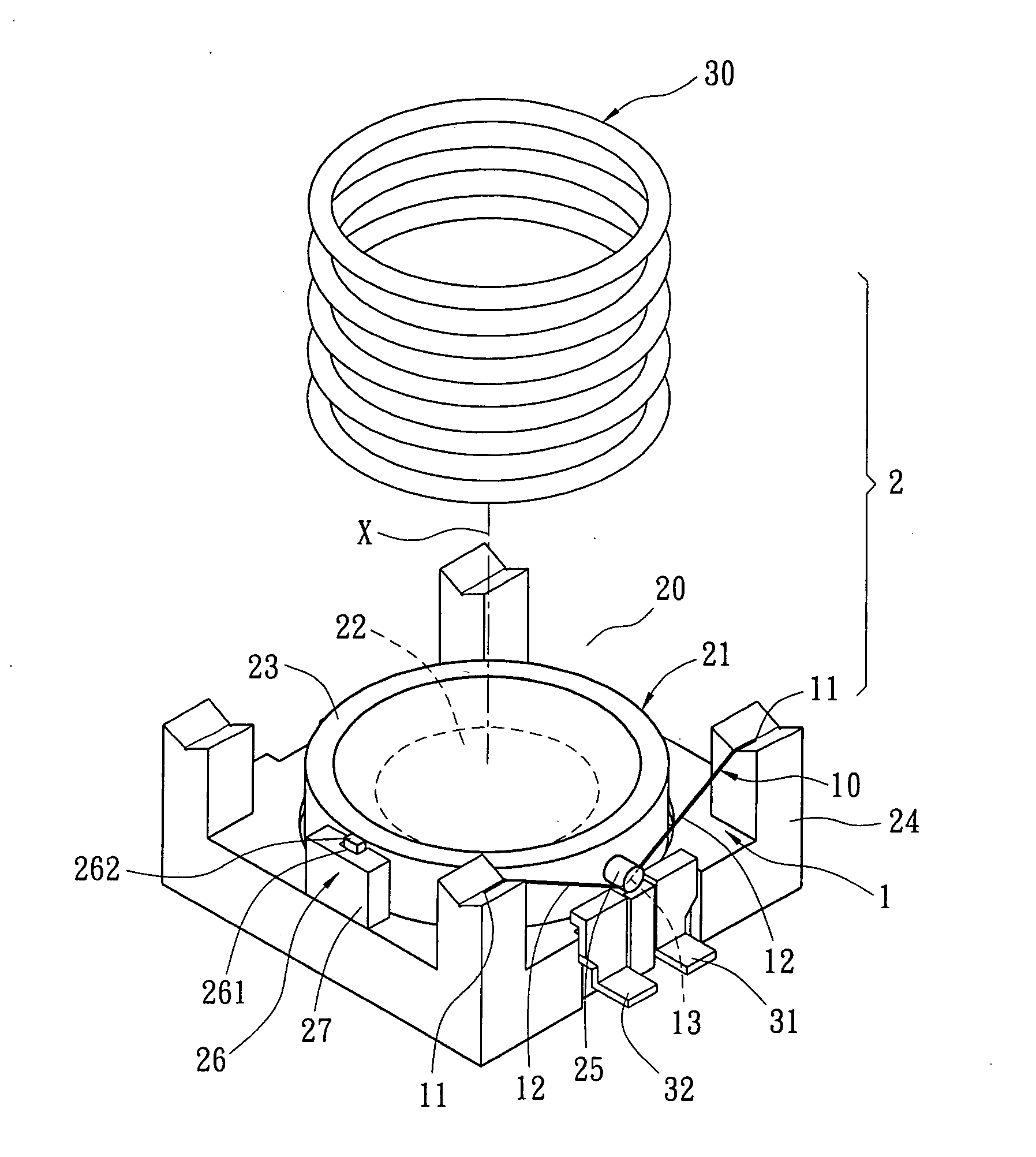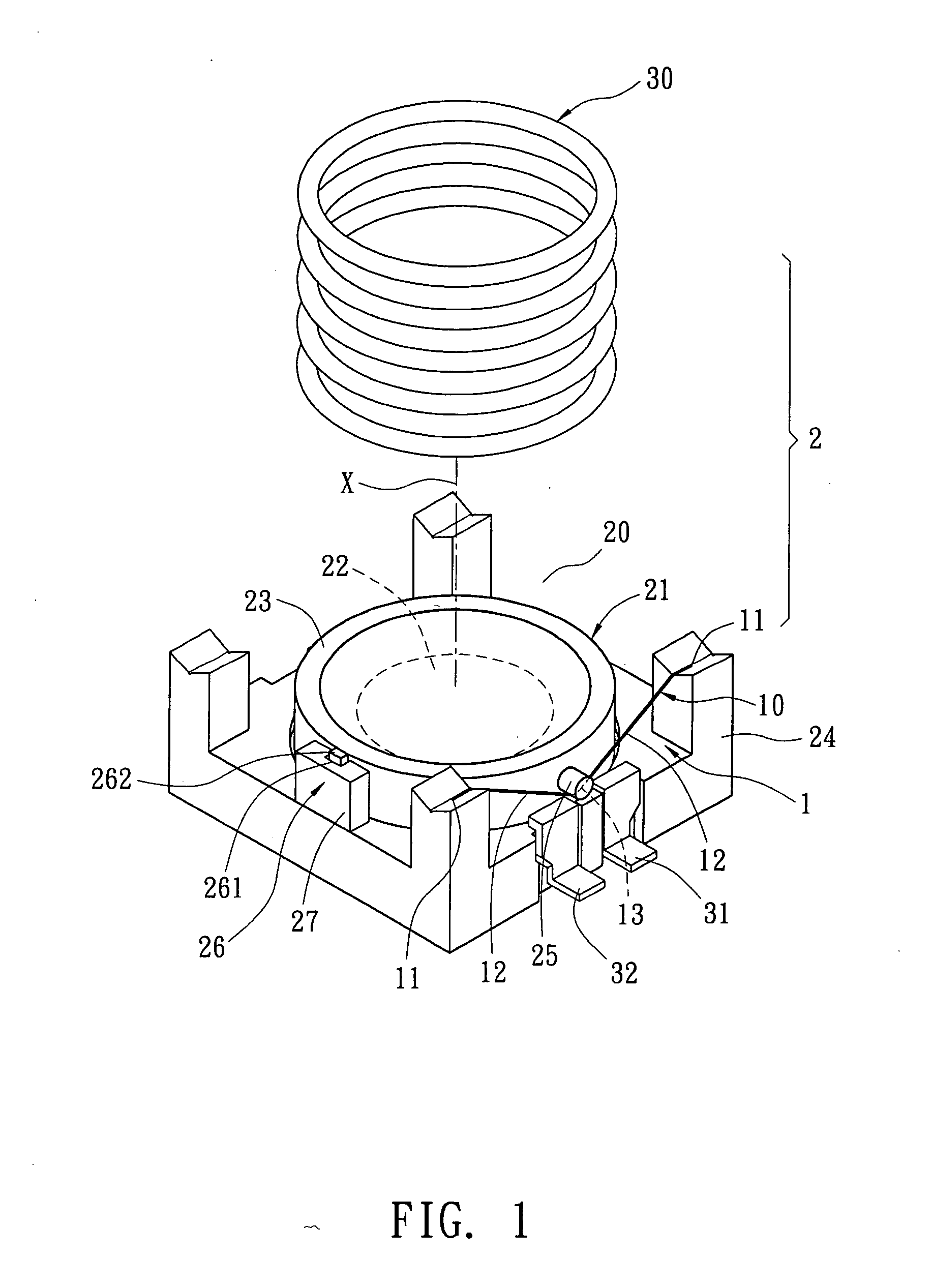Lens displacement mechanism using shaped memory alloy
a technology of shaped memory alloy and displacement mechanism, which is applied in the direction of printers, instruments, camera focusing arrangement, etc., can solve the problems of voice coil motor damage, cost is quite expensive, general piezoelectric material cannot endure high temperature of reflow process,
- Summary
- Abstract
- Description
- Claims
- Application Information
AI Technical Summary
Benefits of technology
Problems solved by technology
Method used
Image
Examples
first embodiment
The First Embodiment
[0021]Refer from FIG. 1 to FIG. 3, one SMA wire 10 is used in this embodiment. When zooming from tele to wide, the lens 21 is moved away from the image side and towards the object side. While zooming, the lens 21 moves under control of a focus button (not shown in figure). When user presses the focus button, the lens displacement mechanism 1 gets control current passed from electrodes 31, 32. After a control current passing through the SMA wire 10, joule heat generates due to resistance of the SMA wire 10. Thus the SMA wire 10 is heated and contracted. Due to linear relationship among the length, temperature and the control current of the SMA wire 10, displacement of the lens 21 can be controlled according to contraction of the SMA wire 10. Thus the distance between the lens 21 and an image-forming plane is changed so as to achieve auto focusing. In this embodiment, the SMA wire 10 is made from Nickel-Titanium alloy with diameter of 0.002″. The distance change be...
second embodiment
The Second Embodiment
[0025]Refer from FIG. 4 to FIG. 6, this embodiment includes two SMA wires 10. The two SMA wires 10 are arranged symmetrically or in equal distance around the lens 21. The driving way and function of each SMA wire 10 is the same with that in the first embodiment. A recovery spring element 30 is disposed on the lens 21 for providing a recovery force in opposite direction to the pulling force of the contracted SMA wire 10 so as to turn the lens 21 back to a balance place.
[0026]Furthermore, a guide rail device 26 is disposed between the lens 21 and the housing 20. The guide rail device 26 is arranged on one side between the two SMA wires 10 so that the lens 21 moves and slides stably inside the housing 20 by the guide rail device 26.
[0027]Or two guide rail devices 26 are disposed between the lens 21 and the housing 20. The two guide rail devices 26 are arranged symmetrically in accordance with positions of the two SMA wires 10. As shown from FIG. 4 to FIG. 6, the tw...
third embodiment
The Third Embodiment
[0028]Refer from FIG. 7 to FIG. 9, this embodiment includes four SMA wires 10. The four SMA wires 10 are arranged symmetrically or in equal distance around the lens 21. For example, the SMA wires 10 respectively are arranged on four sides of the lens 21. The driving way and function of each SMA wire 10 is the same with that in the second embodiment. Moreover, a recovery spring element 30 is disposed on the lens 21 for providing a recovery force in opposite direction to the pulling force of the contracted SMA wire 10 so as to turn the lens 21 back to balance place.
[0029]In this embodiment, four SMA wires 10 respectively are disposed on four sides surrounding the lens 21 so as to provide the lens 21 equipollent contacting and pulling force. Thus the lens 21 moves stably inside the housing 20. Basically, there is no need to add the guide rail devices 26 in this embodiment. Furthermore, once an image quality feedback mechanism is added to control and regulate the fou...
PUM
 Login to View More
Login to View More Abstract
Description
Claims
Application Information
 Login to View More
Login to View More - R&D
- Intellectual Property
- Life Sciences
- Materials
- Tech Scout
- Unparalleled Data Quality
- Higher Quality Content
- 60% Fewer Hallucinations
Browse by: Latest US Patents, China's latest patents, Technical Efficacy Thesaurus, Application Domain, Technology Topic, Popular Technical Reports.
© 2025 PatSnap. All rights reserved.Legal|Privacy policy|Modern Slavery Act Transparency Statement|Sitemap|About US| Contact US: help@patsnap.com



